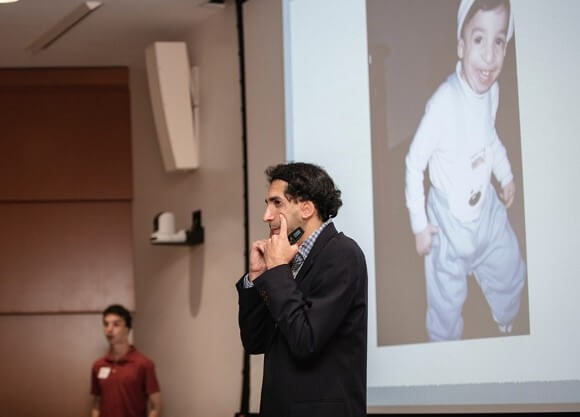
Educator uses personal story to create inclusive classrooms
October 12, 2018

October 12, 2018

Treacher Collins Syndrome is a very rare congenital disorder resulting in both facial anomaly and hearing loss. The condition was vaulted into mainstream awareness by the release of the 2017 film “Wonder.” Drazin spoke to students and faculty from the School of Education about living with TCS, creating an inclusive learning environment and the importance of changing the way we perceive students with disabilities.
“People with disabilities represent the biggest minority group in the world,” Drazin told his audience in the Center for Medicine, Nursing and Health Sciences. “It’s a group that can be joined at any moment by anybody, anywhere.”
Drazin has emerged as a national leader on the subject. Drawing upon his experiences as a student with Treacher Collins and as a teacher in an inclusive classroom, he founded Changing Perspectives, a nonprofit organization that provides educator training programs on disability awareness in schools.
After his introduction, Drazin opened the floor to his protégé, Ryan Bell, a senior at Sheehan High School in Wallingford, Connecticut, who also has Treacher Collins Syndrome. The two recounted their experiences, the extensive reconstructive surgeries they had, and the many social challenges they have endured.
Learn about our education programs
“Stories are powerful,” Drazin said. “Sharing stories builds empathy.”
Empathy, Drazin explained, is one of the 21st century’s most important teachable skills, along with collaboration, networking and communication, and is vital to inclusivity. Unfortunately, many schools lack a concrete way of teaching it.
“Empathy is a conscious choice, and it’s a hard one because it brings up our own vulnerabilities,” Drazin said. “To teach it, we must first raise awareness and foster engagement.”
Drazin offered strategies on how to change students’ attitudes and perceptions about peers with disabilities, and by extension, change their behavior toward them. By doing so, teachers equip students with the tools to become leaders and agents of change themselves in the classroom.
“When someone stares, or asks a question about a disability, it’s usually because they just don’t understand,” Bell said.
Drazin closed by urging future teachers, administrators and other educational leaders in the audience to think hard about what they want the schools they will work in to look and sound like each day.
“The important thing is to seamlessly integrate empathy, as well as social and emotional learning in everything we do, every day,” Drazin said.
Quinnipiac Today is your source for what's happening throughout #BobcatNation. Sign up for our weekly email newsletter to be among the first to know about news, events and members of our Bobcat family who are making a positive difference in our world.
Sign Up Now